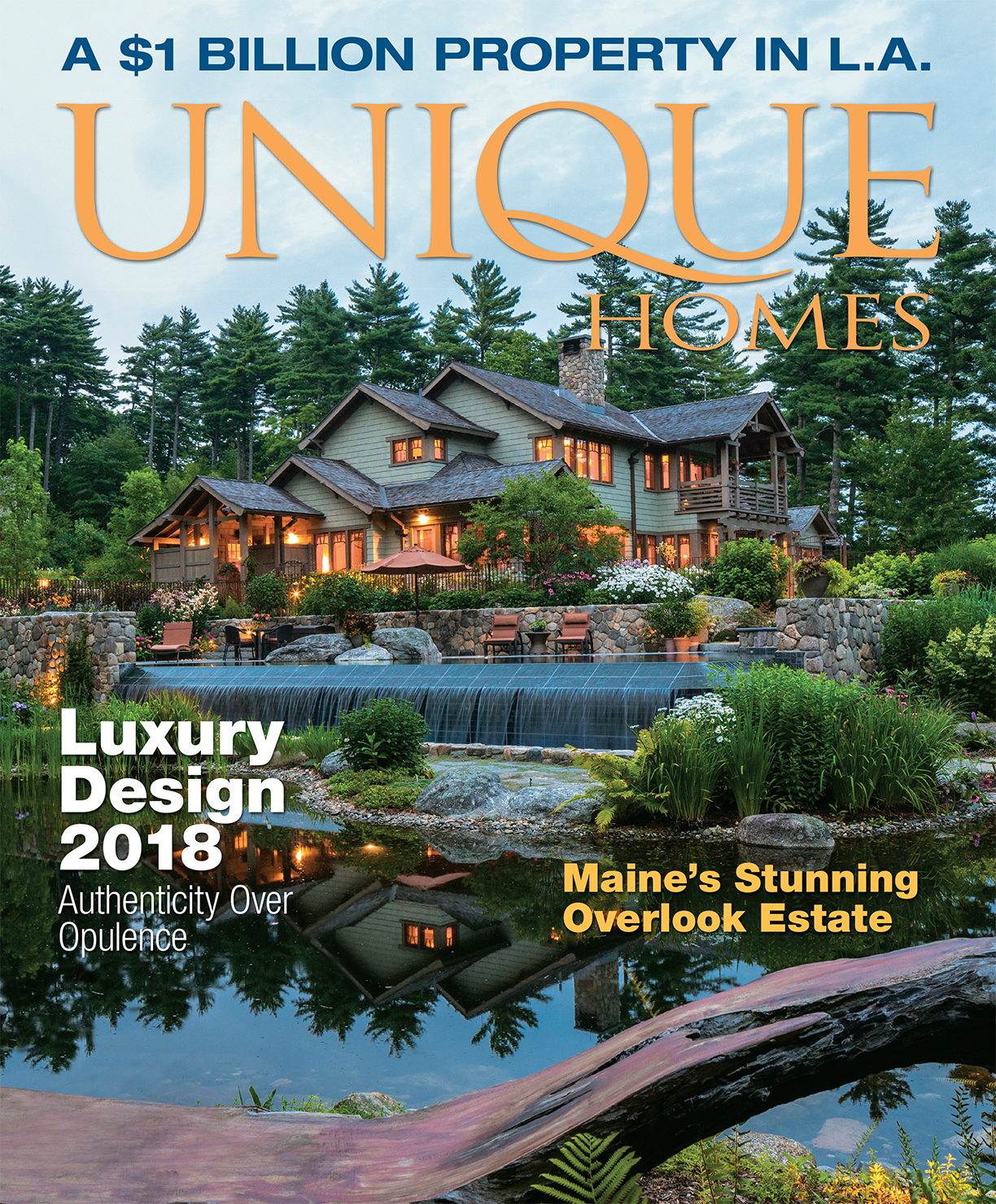In 1932, when the impressive Grand Rex Theatre opened its doors in Paris, 80 doormen donned in white gloves and tails greeted guests for a night of glamour and luxury. A night at the theater was an occasion for fine attire, lively socialization, and entertainment. Today, although streaming services have taken technology to the next level and brought the big screen right into our living rooms, the experience is far from the same.
The Open Air Cinema Kamari in Santorini, Greece is a stunning outdoor theater that is surrounded by eucalyptus trees and offers a variety of locally produced wines and ice creams to enjoy alongside movie showings. The owner, Ina Koutroubilis, says, “Our guests tell us that the cinema is like an enchanting secret garden that harks back to the Golden Age of cinema. They come for the whole experience.”
The Oriental Theatre in Milwaukee, Wisconsin, was constructed with details from Indian, Moorish, Islamic, and Byzantine architectural styles and is known today as Milwaukee’s Historic Movie Palace. Karina Henderson, marketing director of Milwaukee Film, notes, “You can watch a lot of movies on your screen at home, but the experience of going into a magnificent building, sitting in a dark theater, putting away your glowing screens for a couple of hours, and letting yourself be immersed in someone else’s story — that’s an amazing thing in this day and age.”
In a world of commercial-free marathon-watching, a night out at the theater is even more of a luxury than in the past. These otherworldly theaters around the world take entertainment to a higher level.
Open Air Cinema Kamari
Santorini, Greece
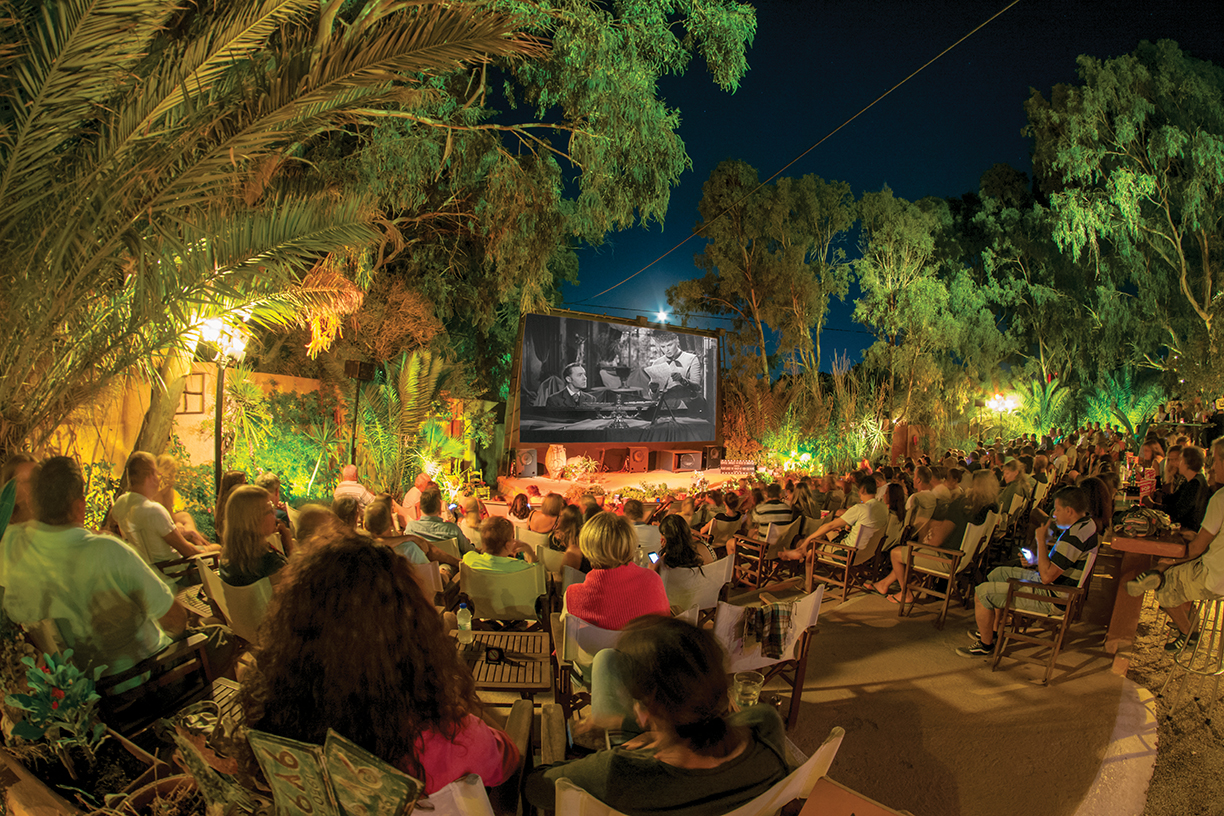
Open Air Cinema photo by cinekamari.
The Oriental Theatre
Milwaukee, Wisconsin
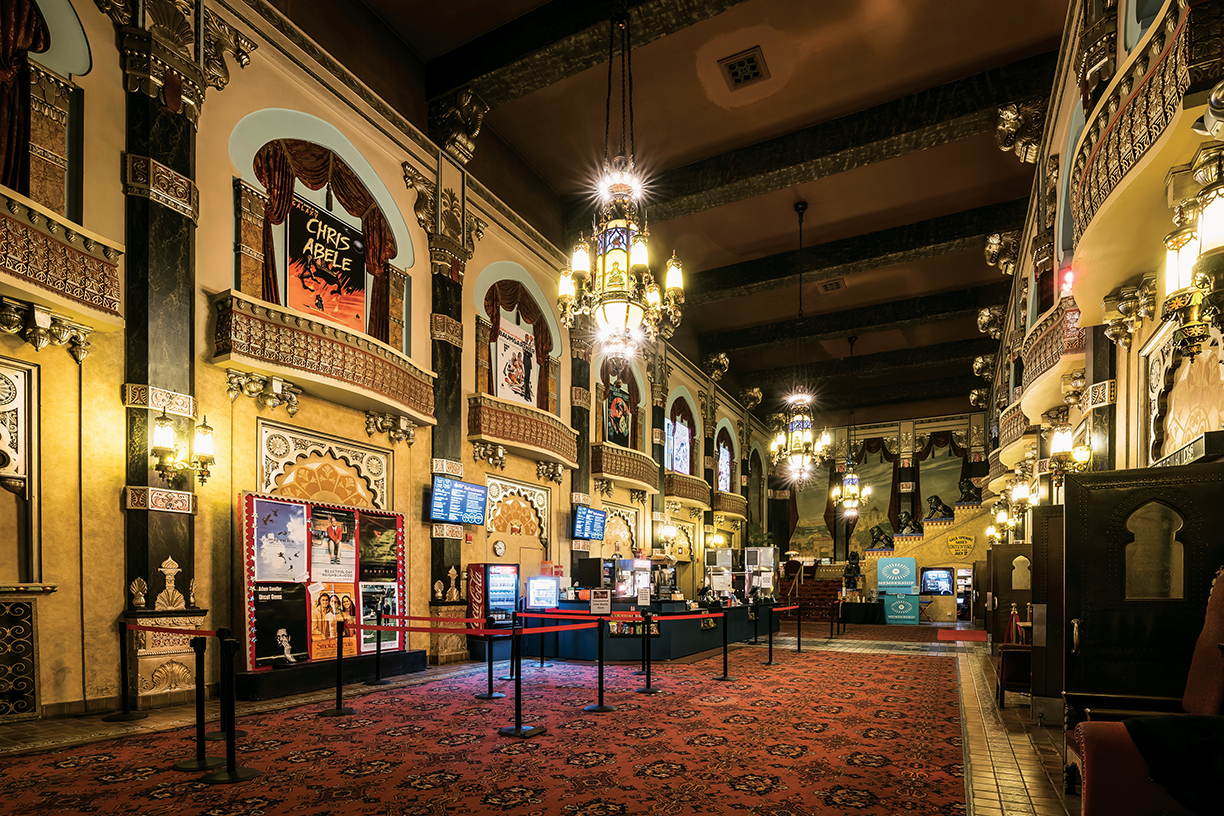
Photo by Jake Hill / milwaukee film.
Foreign Cinema
San Francisco, California
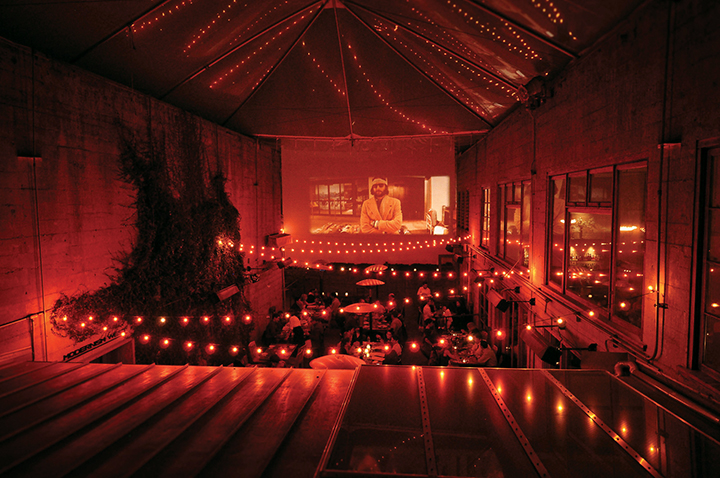
Photo by Charlie Villyard Photography.
Elevated with Flavor
Foreign Cinema in the Mission District of San Francisco, has been a San Francisco Chronicle “Top 100 Restaurant” for 18 consecutive years and is first and foremost a restaurant. Yet the added 35-millimeter films displayed nightly on their outdoor courtyard screen transforms the establishment into an intriguing combination. This pairing of food and film is not a new one, but one that continues to appeal to guests. Gayle Pirie, co-owner/co-chef of Foreign Cinema, explains that at Foreign Cinema, they united culinary and cinematic experiences in an honest way that proved successful.
“At the restaurant, visual media collides in such a way that the aesthetics of the screen flicker easily alongside the vibrancy of the plates,” says Pirie. “This pairing makes sense since the Mission neighborhood, where the restaurant is located, has a rich theatrical past. In the 1950s, it was the city’s hub for movie theaters. In many ways, we’re honoring this legacy while spotlighting the ideals and flavors that have come to define California cuisine.”
Foreign Cinema’s refined menu elevates the experience to an even higher standard. Keeping with seasonal and local ingredients common in California cooking, the restaurant also draws on inspiration from the Middle East and Africa. “Our sesame fried chicken with madras curry and spiced honey is a signature dish we nearly never take off the menu,” says Pirie.
Another example of food and film can be found at the Edible Cinema in London, England, where each guest is supplied with a variety of mystery boxes containing a small tasting menu tailored to specific moments in each film. The element of taste enhances the experience and entertainment without competing for attention.
Inspired Settings
The Paris Theatre was the last single-screen movie theater in Manhattan. With its history and overall classic atmosphere, many were highly disappointed when the doors closed in August 2019. According to The New York Times, the theater was a favorite among locals and tourists and was known for playing foreign films in their original languages.
Although the venue closed, a surprising new owner has reopened its doors — Netflix. The streaming company will use the theater for Netflix-original movie debuts, special events, and other screenings. The venue is over 70 years old and instantly brings to mind the Golden Age of cinema as it sits across from The Plaza in bustling Manhattan.

The Grand Rex Theatre
Paris, France
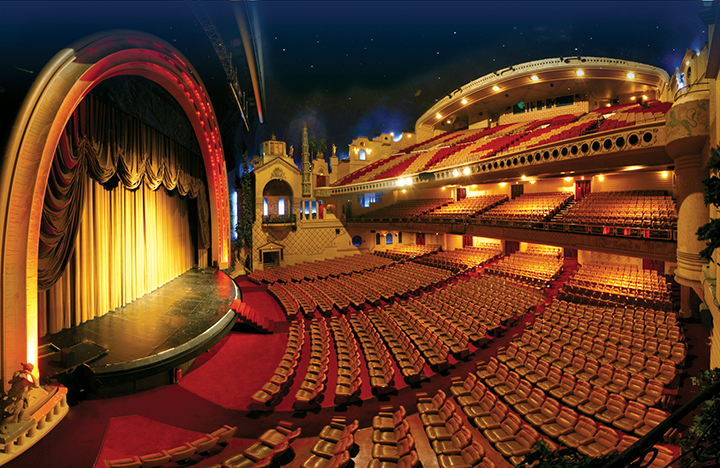
Top photo from Picasa.
Bottom photo courtesy The Grand Rex.
The setting of these theaters begins the journey for guests and sets the tone for the afternoon’s entertainment. For the Foreign Cinema, “The long corridor leads to an unexpected oasis, much like the rabbit hole in Alice in Wonderland, with a climactic courtyard scene illuminated by the flicker of our 35-millimeter projected films and juxtaposed with the roaring hearth centered in the main dining room, all encompassing the warmth of our community of diners,” according to Pirie.
When entering the Open Air Cinema Kamari, “You will find yourself in a lush green garden, surrounded by eucalyptus trees and fragrant night-blooming flowers. We usually play ’50s Jazz music and together with the decoration and lighting design, guests are already enchanted,” says Koutroubilis.
Glitz and Glamour
It was not uncommon for guests to arrive at theaters in sequined ball gowns and tuxedos at the start of cinema and for many years to follow. Although there are more casual options for viewing movies today — such as the living room sofa — the idea of luxury is still a defining component for theaters around the world. According to Henderson, “The grandeur of our building makes any movie into an event,” she says about The Oriental Theatre. “It’s uplifting to be surrounded by the beauty of a gem like the Oriental Theatre, and then sit down and watch an amazing film.”
Similarly, the decadence at The Grand Rex has stood the test of time and continued to draw guests in, only to convince them to return time and time again. Along with the balcony seating and fine finishes, the star-covered ceiling gives the illusion that guests are outside, adding to the glamour of the venue.
There was a sense of community and conversation that stemmed from early theaters when guests would dine, enjoy a film, and then go dancing afterward, making it a whole night of glamourous entertainment and socialization. The theater was a way to experience and learn about far away people and places, which not everyone had the opportunity to enjoy and is still a part of the appeal today. “In 2019, we brought 349 titles from 45 countries over 15 days to our film-loving Festival-goers. It’s truly a community event, and the Oriental Theatre is always busy during the Milwaukee Film Festival,” says Henderson. “Watching a film in a theater is still a special experience that you can’t replicate at home on your TV or tablet.”
Whether you’re hosting a clambake on Nantucket, enjoying a procession of edible jewels at a Tokyo sushi bar or simply shopping for a suburban supper, the days of consuming seafood with careless abandon are gone. The oceans are desperately overfished, and seafood lovers must be conscious of their own personal impact on the aquatic environment.
The best known resource for both suppliers and consumers is Seafood Watch, a program created by the Monterey Bay Aquarium in Northern California 20 years ago. Its regional consumer guides, identifying the most sustainable and most threatened species, are valued by consumers, chefs and eco-conscious corporations. “We use a rigorous, scientifically-based standard to come up with recommendations, result-ing in the most up-to-date, credible information,” states Maddie Southard, content manager for Seafood Watch.
So influential are these guides—60 million have been distributed to date—that when a particular item moves from the red (“Avoid”) category to yellow (“Good Alternatives”) or green (“Best Choices”), millions of dollars can change hands. Reflecting the thoroughness of Seafood Watch’s recommendations, flounder appears four times as a “Best Choice,” 14 times as a “Good Alternative” and 18 times in the “Avoid” column depending on the exact species, geographic origin and methods of fishing or farming employed.

©Monteray Bay Aquarium, Photo by Tyson V. Rininger.
“Consumers help drive change, and when businesses recognize what’s import-ant to consumers they respond,” reports Southard of Seafood Watch’s ability to engage corporations like Whole Foods and Blue Apron. The program’s restaurant partners transcend economic strata, from trendy Farallon in San Francisco to family-friendly Red Lobster restaurants across the country.
In its early days, businesses viewed Seafood Watch as a fringe movement but today participation is embraced and display of the organization’s yellowfin tuna logo can be a marketing asset. A Blue Ribbon Task Force, comprised of honored culinary authorities, enhances Seafood Watch’s relevance with diners. “The public admires chefs and culinarians, and we realized the impact they have on consumers,” offers Southard, who adds, “Chefs were some of the earliest supporters of the movement so this was a natural partnership.”
“Whenever I’m making decisions about what to put on a menu, I always ask myself, ‘What would Sheila do,’” says Los Angeles chef Michael Cimarusti, referring to Seafood Watch’s Sheila Bowman, who oversees outreach to chefs. Cimarusti, who has earned two Michelin stars at his flag-ship restaurant Providence, became conscious of sustainable sourcing issues as a young chef in L.A. 20 years ago, when a Gourmet magazine review admonished him for serving bluefin tuna.
“As I learned more about issues relating to sustainability, I became really passion-ate about it and wanted to become more active in the movement,” explains Cimarusti. “I was honored to be asked to sit on the Task Force and have learned a tremendous amount from Seafood Watch,” says the chef, who shares all of the program’s recommendation alerts with his staff.
Éric Ripert, chef/partner of New York’s Le Bernardin, takes sustainability as seriously as Cimarusti. “I spend my days with many varieties of fish, considering which are best for the restaurant, he says. Ripert explains, “This means more than just judging by flavor and composition, but includes the ethics and politics surrounding how they’ve been made available to us.” The Michelin three-star chef cautions, “If we don’t support the artisanal way of catching fish, it’s going to disappear.”
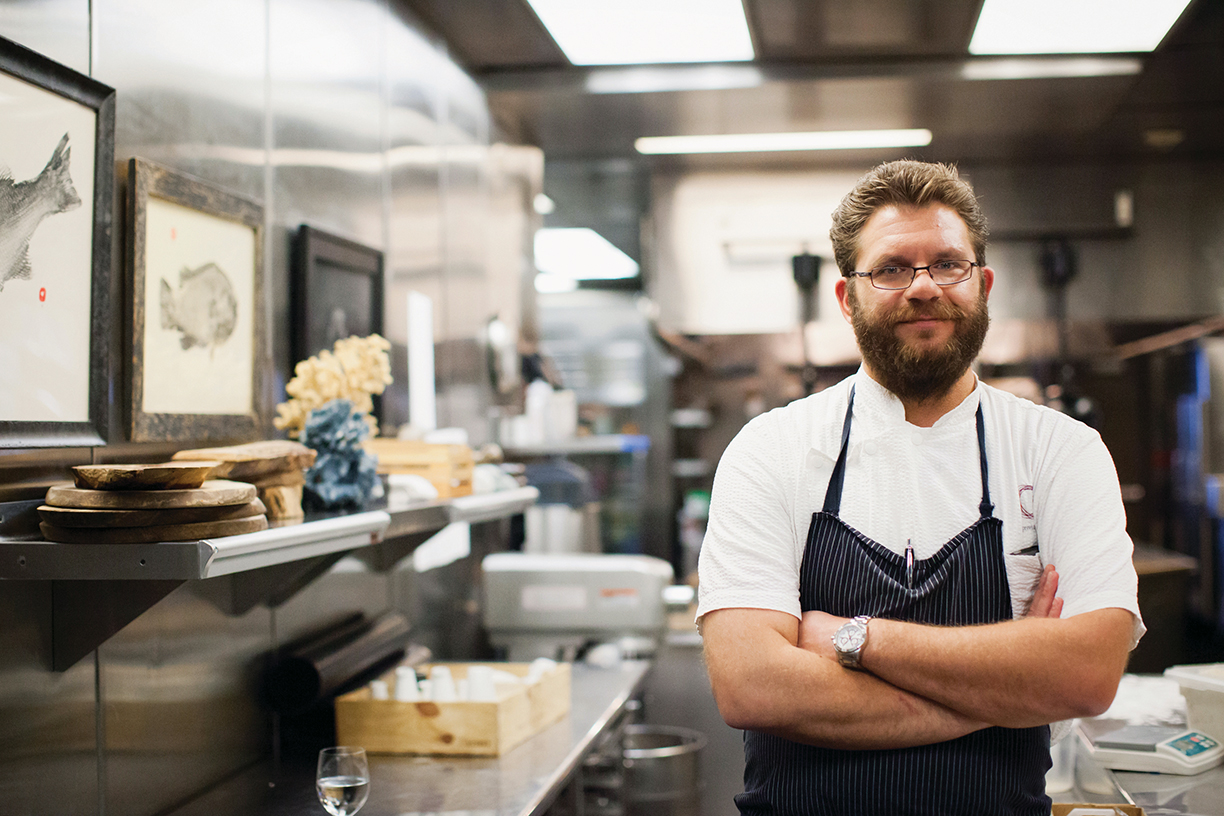
Michael Cimarusti. ©Jennkl Photography.

Courtesy of Whole Foods Market.
Hugh Acheson, author and James Beard Award-winning chef with a family of Georgia restaurants, also sits on Seafood Watch’s advisory board and is a strong advocate for local, sustainable ingredients. He recalls that in the 1990s chefs addressed a severe threat to swordfish through a voluntary ban and use of more sustainable alternatives, allowing stocks to replenish. “It made me realize how much clout we have, as chefs, to mandate change when we act as a plurality,” states Acheson.
“I think Seafood Watch has succeeded in being a valuable resource for consumers, chefs, wholesalers, and grocery stores,” says the Canadian-born chef who has helped reimagine Southern cuisine. Acheson, who notes that swordfish continues to face challenges, suggests Seafood Watch would have been an invaluable resource decades ago, when many chefs were oblivious to sustainability issues.
An affinity for bluefin tuna (maguro) and eel (unagi), both largely on Seafood Watch’s “Avoid” list, and adherence to centuries-old traditions makes sushi chefs among the most reluctant to adopt sustainable practices. One sushi chef committed to sustainability is Bun Lai, chef/owner of Miya’s Sushi in New Haven, Connecticut and another member of Seafood Watch’s Blue Ribbon Task Force. Some odd ingredients—every-thing from insects and invasive species to edible weeds—populate his voluminous menu, and the James Beard Award nominee relies on guidance from Seafood Watch.

Éric Rippert. ©Daniel Kreiger Photography.

Hugh Acheson. Photo by Emily B. Hall.
“Miya’s started working on sustainable seafood very gradually in the early 2000s,” reports Lai, explaining that unreliable data made conscientious sourcing challenging. “Monterey Bay Aquarium’s Seafood Watch changed all of that by creating a tool that helped people choose sustainable seafood in a market awash with imported seafood of mostly dubious origin and quality,” says Lai. “When I first discovered Seafood Watch, it was as if a light beamed into the darkness I was surrounded by,” he says.
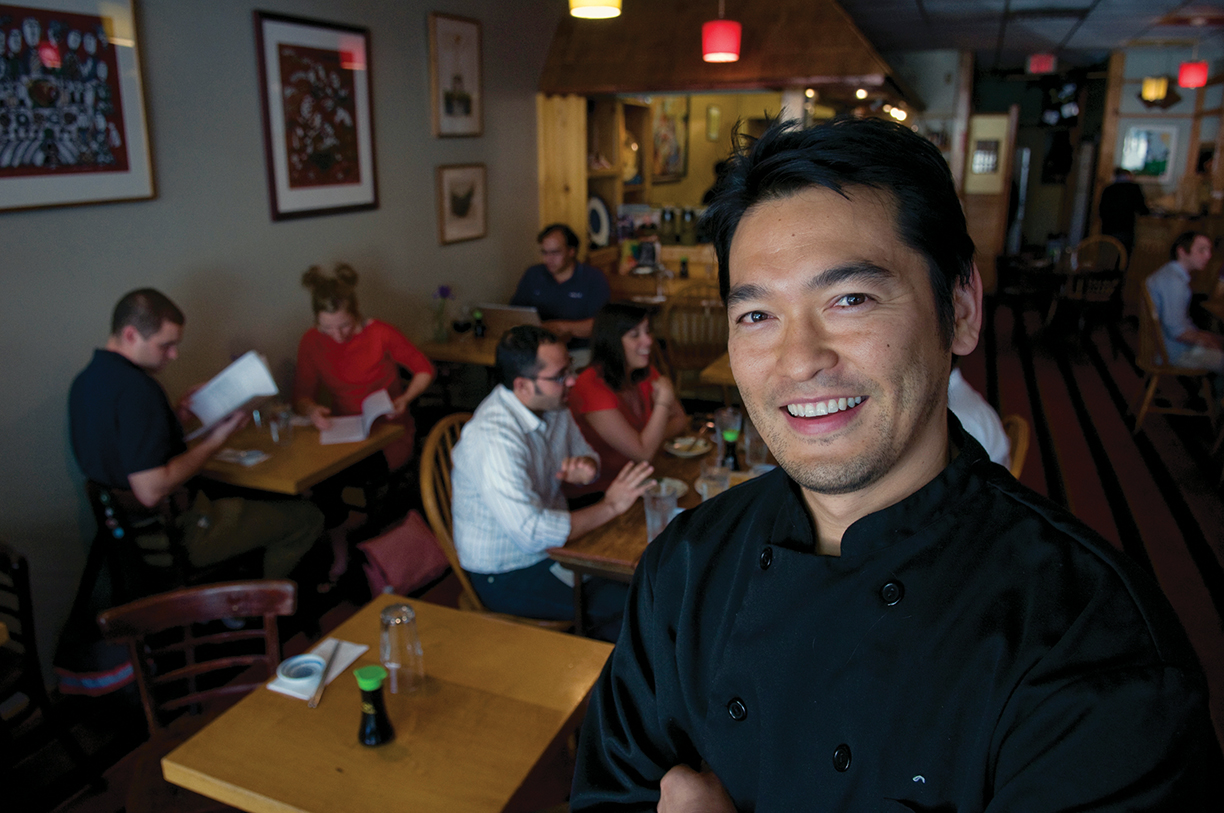
Bun Lai. ©Alan S. Orling.
“I admire my heritage, but we must question our traditions, too,” states Lai, acknowledging sushi’s popularity contributes to overfishing around the globe. He cites Jiro Ono, the revered sushi master featured in the documentary film Jiro Dreams of Sushi, who lamented the demise of the majestic bluefin while continuing to serve it to customers.
“There are, however, sushi chefs filled with a passion for sustainable seafood like those café owners who pioneered fair trade coffee decades ago,” says Lai with optimism. With Seafood Watch’s guides and app available to chefs and consumers alike, good choices can be made on both sides of the bar.
Sustainable Sources
Hugh Acheson
www.hughacheson.com
Le Bernardin
www.le-bernardin.com
Miya’s Sushi
www.miyassushi.com
Providence
www.providencela.com
Seafood Watch
www.seafoodwatch.org

Photo courtesy Niio.
Smart technologies and artificial intelligence are changing the way we consume art.
While many treasured works of art are safely contained in notable museums or in the homes of experienced collectors, a new tide is cresting along the shores of the art curation field with the influx of digital art.
Digital art, more widely known as new media art, is an interesting sector of the art industry to define, even for Beryl Graham, who is a professor in New Media Art at the University of Sunderland. She notes that the roots of this art form have drawn inspiration from a range of movements, from conceptual artwork to video art, which also began in the 1960s.
“It’s broadly digital but [it’s also] the kind of art that works in different ways in different kinds of behaviors,” Graham notes. One fascinating example would be an exhibition of software art in which the software, sometimes even artificial intelligence-based artwork, can learn and grow on its own. Graham explains that an artist might start a piece of software and watch it evolve, perhaps give it a virus and watch, showing to the audience that the “end point isn’t quite under the control of the artist.”
Magdalena “Magda” Sawon, owner of the contemporary art gallery Postmasters Gallery in New York, says that the digital age has only heightened the senses of curators and artists, who are traditionally at the forefront of new developments in culture and technology.
“Technology is a tool,” she notes, “it is also a moving target and changing constantly. The question is to be aware of new developments and adapt it intelligently to one’s needs and benefit.” Fittingly, as artists have been harnessing the power of technology within the art industry, curators and galleries have had to “keep up with the times,” and embrace digital forms of artwork and the systems and methods in which they are displayed.
Donna Holford-Lovell, director of The North East of North festival (NEoN), notes how the incorporation of interaction and participation into art displays appeals to today’s technology-savvy audiences that have been gradually reinvigorating focus on the digital art world.
“The idea of ‘curation’ has become ubiquitous and our audience is seen to be curating many aspects of their own lives,” Holford-Lovell says. NEoN is an organized event that aims to advance the understanding and accessibility of digital and technology-driven art forms by having the artist and curator work together to translate “the spectacle of experience,” via digital platforms within physical spaces, like virtual reality, artificial intelligence, and even social media.

JONATHAN MONAGHAN (US)
The Phoenix and the Medusa (2018), Video, 7 min 69 sec, Edition of 30, Niio Commission Series.
With systems and platforms, from artificial intelligence to online-based forums, both artists and curators now are developing larger platforms and databases to contribute toward. As well as an educator, Graham is co-founder and editor of the Curatorial Resource for Upstart Media Bliss, or CRUMB, a resource for curators of new media art that aims to help overcome any challenges presented from this rise in digital art, from installations to networks of artists and individuals versed in these practices.
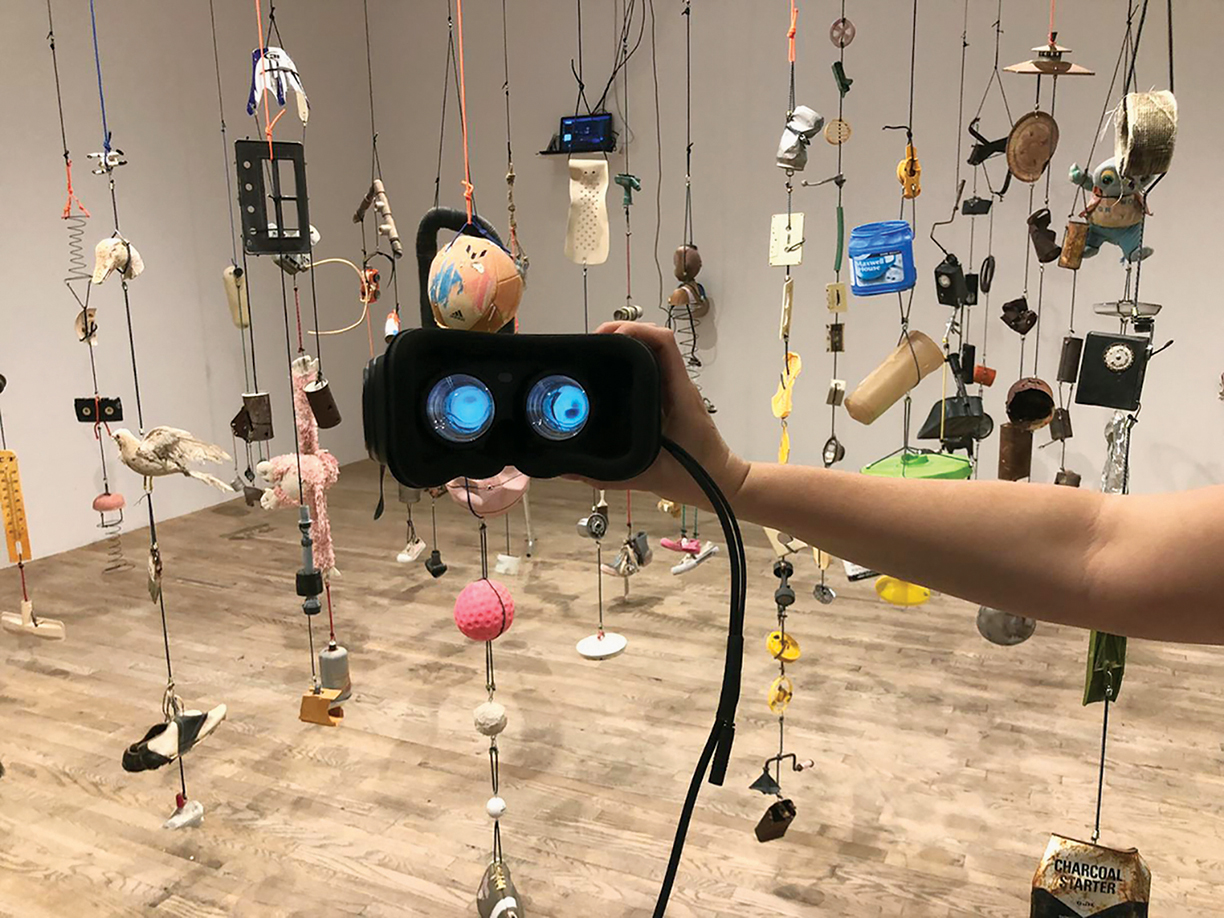
PERRY HOBERMAN
Suspensions (2018), VR and mixed reality installation, Postmasters April 2018.

QUAYOLA (UK)
Camouflage (2018), Moving Image, 6 min 4 sec, Edition of 30, Niio Commission Series
On the luxury spectrum of art curation, Niio is a brand integrating digital art and technology-driven forms of collection and distribution that surges past the limitations of traditional artwork. Niio is an art and tech company aimed to enable the exposure of digital artwork in a time that to the company feels like a fourth industrial revolution.
“Art has always reflected the world we live in,” says Rob Anders, CEO and co-founder of Niio, “and artists will create their art with any tool they can access.” In today’s world, that tool has come to be technology. Anders, who understands the eclectic background of digital art from conceptual and video art, wanted to help designers and architects best fit homes with the art of today, and after speaking with top galleries he found that what’s really needed are new models of both the business and technological side that reach a broader audience — even better: one with a subscription.
“We envision a world where in homes people will have more digital canvases with interactive or immersive works, all on a centralized connected system that can very easily change,” Anders says, with access to top artists in the world in this ecosystem of artists, galleries and collections all on the Niio platform. Luckily, the CEO notes, the technology is “already there,” from artificial intelligence in devices like Amazon’s Alexa devices to smart televisions, all devices that can easily work with the Niio platform to display digital artwork.
To those interested in having access to the “world’s finest art accessible on-demand,” Niio is open as a limited edition membership at about $5,000 a month, with access to curated exhibitions and collections, or art “playlists” of over 7,500 art pieces on the platform that can be easily changed and displayed on devices like smart TVs, projectors, screens, et cetera, which can be installed by Niio technicians as well.
“Art curation is telling a particular story,” he says. “In order to give people these digital works, it’s not about just finding the individual works, it’s about giving people the ability to learn about the works they are looking at,” he says.
Like a butterfly opening its wings, two meticulously crafted oak and aluminium front covers fan out, and a thin screen rises to perfect viewing height.



Bang & Olufsen has unveiled Beovision Harmony — a TV experience that elevates the design of any living space and fills it with spectacular sound. When Beovision Harmony is turned off or just playing music, the thin screen rests close to the floor, partially covered by two meticulously crafted oak and aluminium front covers. When Beovision Harmony is turned on, the front covers fan out and the screen rises to the perfect viewing height. Turn off the TV, and the finely choreographed sequence plays out in reverse.
“Pristine picture performance combined with truly immersive sound ensures a mesmerizing viewing experience. But the presence of a big screen is rarely a welcoming addition to living spaces. With Beovision Harmony, we wanted to create a meaningful object for the interior that reduces the visual presence of the TV and transforms it into something that people will develop an emotional attachment to.” — John Mollanger, Bang & Olufsen’s executive vice president of brand and markets.
The oak and aluminium front covers conceal a sublime and powerful sound center, delicately tuned by hand and ear to reveal all details of music and sound. The intricate grading pattern is carefully designed to maximize the acoustic performance of the three-channel, fully active DSP-based sound center.
The concept behind Beovision Harmony builds on some of Bang & Olufsen’s most cherished products. The Capri series, introduced in 1959, was designed to fully integrate with the living room. Hence the TV was built in teak, which was the preferred wood for furniture at the time.
“We have been sharing an obsessive passion for almost 100 years, and it has been a mission of ours to perfect the techniques used to reproduce sound and vision and to embody it in a design that people are proud to have in their homes,” says Mollanger.
Beovision Harmony is designed as a centerpiece for home entertainment. Boasting a robust speaker system with serious sound capabilities, Beovision Harmony offers impressive music streaming with integrated music services like Tune-In and Deezer. Beovision Harmony also comes with LG’s most recent webOS 4.5 platform, which allows you to access your favorite media service providers.
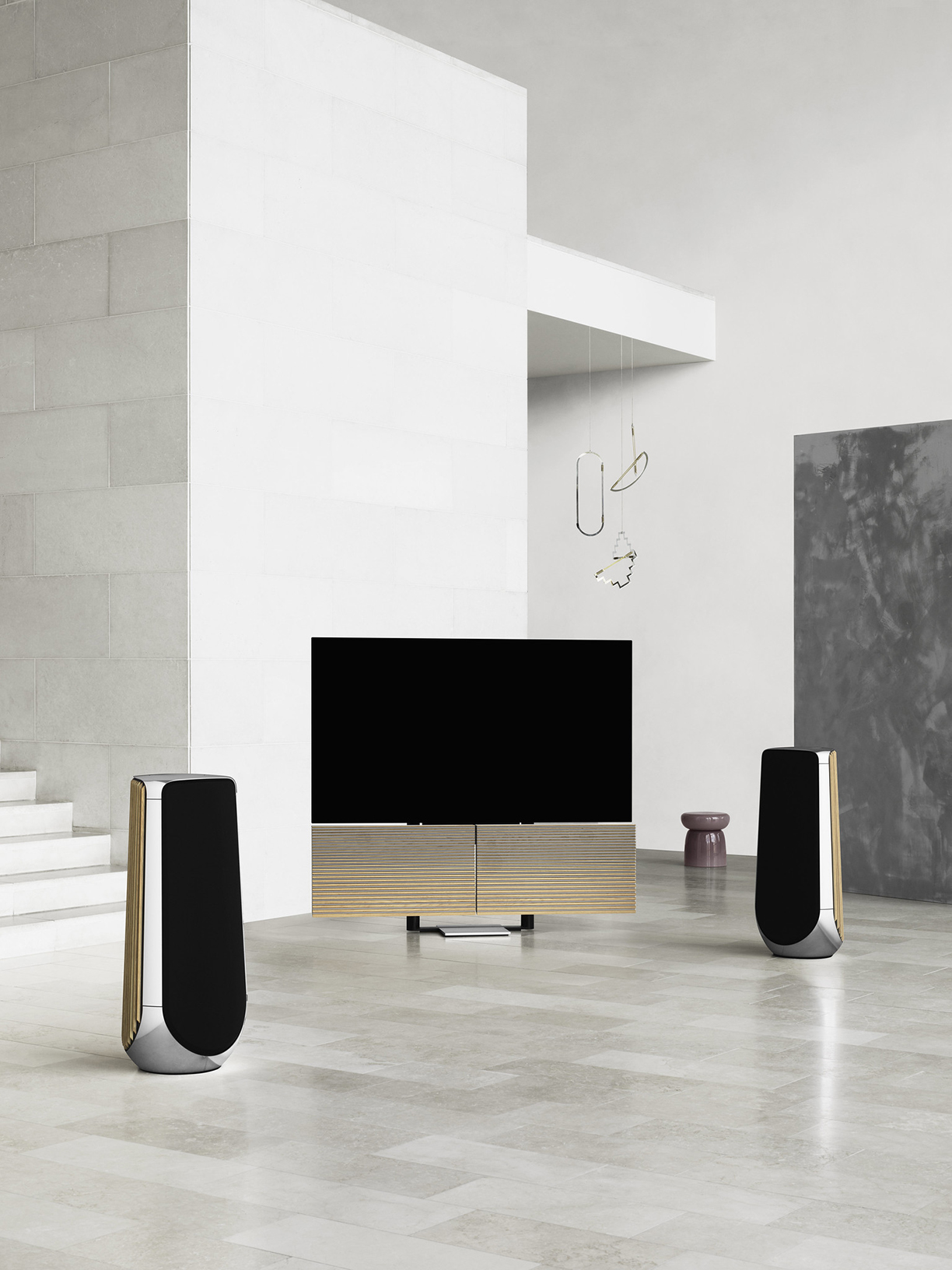
Images courtesy of Bang & Olufsen
Beovision Harmony is estimated to retail from €18,500 and will be available in Bang & Olufsen stores starting October 2019.
FOR YEARS, NEW TECH COMPANIES HAVE BEEN THOUGHT OF AS THE ‘DISRUPTERS’ IN THE REAL ESTATE INDUSTRY. BUT SAVVY REALTORS ARE POSITIONING THEMSELVES AS THE AGENTS OF CHANGE.
The current market shift from buyers to sellers generates the most attention, but the number of sales and pace of price appreciation are only one swell in the wave of transformation rolling through the real estate industry. Technology is typically hailed as the disrupter, but changing demographics, new lifestyle aspirations and evolving buyer preferences are all at play in today’s real estate landscape.
“If you ask anyone that has been in the business more than 10 years, they say ‘here we go again.’ More paperwork, more platforms, more new companies, more new agents. Yet, ultimately real estate is the same. Our clients require handholding, advice, and moral support, deals get negotiated, and transactions finalize or fall apart. Yes, there are slight shifts in the marketplace, but generally, it still functions the same,” shares Lucio Bernal, a broker associate with Coldwell Banker Residential Brokerage in Palm Springs, who is also an expert trainer with the Institute for Luxury Home Marketing.
What is changing is almost every other aspect of real estate from tools to facilitate broker client relationships to virtual reality apps enabling buyers to envision making a prospective property their own. Increasingly agents are looking to their brokerages to keep pace with technology. “They are leaning on their brokerages, more than ever, to help arm them with tools, from digital marketing to smart, proactive customer relationship management systems (CRMs) that will keep them cutting edge, as well as those they can’t afford to leverage on their own,” says Stephanie Anton, president of Luxury Portfolio International. Additionally, affiliate groups like Luxury Portfolio and major brands have amped up marketing capabilities so agents can easily create a cohesive campaign.
There might be a technology revolution taking place in real estate, but market shifts are reinforcing the importance of the agent. “Technology has always been the present. It’s how you use it that benefits you the most,” shares Bernal. “The perfect example is: If you are dealing with a consumer, they are more likely to use you based on reputation and recognition than whether you know a certain app or technology platform. Technology should be used as a resource and compliment your ability to get face-to-face and maintain contact with a consumer.”
At this time last year, blockchain and the impact of virtual reality and artificial intelligence on real estate were being debated. Today, the chatter is about portals morphing from search engines to places to buy and sell homes, a new classification the industry characterizes as iBuyers. Opendoor, founded in 2013, started the trend, followed by others including Offerpad and Knock. Zillow and Redfin have also introduced iBuying in some markets. iBuyers purchase consumer’s homes outright using analytics that enable them to come up with a price based on the home’s perceived value, usually within days. Unlike homes sought by flippers, these are not troubled properties and offers reportedly are close to the value estimation. Other portals are beefing up offerings for consumers, adding mortgage and title services. Startups such as Purple Bricks offer a new twist on the flat-fee concept.
Investor dollars from venture capital and hedge funds are flowing into real estate, fueling many new ventures, which is another change potentially revamping the industry. “Everyone is investing in technology to disrupt or change real estate,” says Mark Choey, co-founder of Climb Real Estate, a San Francisco brokerage, which was acquired by Realogy’s subsidiary NRT in 2016. The real estate industry is rapidly shifting, and innovation is not just welcome, it’s desperately needed,” said founder Chris Lim, whose background is in marketing. Choey hails from the tech sector. Climb was the first brokerage to work with Matterport and continues to incubate emerging apps and work with new vendors.
ENABLING THE AGENT
Among traditional brokers, Keller Williams and RE/MAX are often noted for new tech initiatives, but almost every brand and national affiliate group is boosting technology offerings and platforms, often through relationships with providers and new tech venders including virtual staging, enhanced CRM and 3D tours and imaging. Technology ultimately benefits consumers, but traditional brands and affiliates say their focus is enabling their agents to do a better job.
“Everything has shifted in many different areas from the brokerage level, the buyer level, who the buyers are, what they are looking for,” says Sally Forster Jones, executive director, Luxury Estates, Compass. “I think there is a shift in the way that brokers are functioning. They are more innovative with more technology and more marketing as opposed to the older traditional real estate firms.
“Consumers care about responsiveness. They care about the fact that if they reach out to an agent, whether it be on their website or mobile app the agents gets back to them instantly, and technology can help with that,” says Marilyn Wilson, founding partner of real estate consultants WAV Group and also a founder of RETechnology.com.
“Technology has always been the present. It’s how you use it that benefits you the most. The perfect example is: If you are dealing with a consumer, they are more likely to use you based on reputation and recognition than whether you know a certain app or technology platform. Technology should be used as a resource and compliment your ability to get face-to-face and maintain contact with a consumer.”
Tapped by Google to create a virtual staging app using augmented reality, Sotheby’s added Curate to agent toolboxes last year. Not only can a homeowner visualize a home before buying, but a partnership with a home furnishings company allows potential buyers to virtually furnish the home as well.
“A depth of understanding of what a property has is really important to consumers. The other thing that consumers are responding to online are floorplans,” says Wilson.

GETTING REAL WITH VIRTUAL
In the last year, GeoVC, a tech start-up offering 3D immersive tours and floorplans that can be created using next generation smartphones, integrated virtual staging, exterior 3D scans, and aerial 360-degree panoramas captured with a drone with interior 3D tours. “Outdoor imagery is captured using a regular drone, automatically processed into a 3D model, and integrated together with interior virtual tour. Such an exclusive experience will differentiate luxury properties with beautiful facades and roofs, and spacious lots,” shares Anton Yakubenko, co-founder and CEO of GeoCV.
“Luxury has really turned into personalization now,” comments Thompson. Tools like Curate, RoOomy and virtual staging apps enhance opportunities for personalization. Thompson explains: “Someone can walk into a home and say, ‘not my style,’ but it doesn’t matter because I have the tools that allow me to make it feel like what I want it to be.”
Even Compass, which touts itself as “The first modern real estate platform, paring the
industry’s top talent with technology,” says technology is there to benefit the agent. “Compass is building for the agent. Every program, tool, and service is (created) with the agent in mind. Many of the other real estate technology companies out there are working to improve the consumer experience and not focusing on the agent. We believe that by empowering the agent, consumer experience will be improved,” says Sarah Vallarino, head of West Region Communications at Compass.
“Talking to agents, the message we consistently heard was ‘give us technology,’” says Thompson. “They didn’t necessarily know what that technology was just that they needed it. They understood that the industry was changing, and consumer behavior was changing. They know because they’re the boots on the ground and so they can feel the shift in consumer behavior.”
As markets shift, agents are retooling, once again looking at how they do business and what skills and knowledge will be required. “It’s always either somewhat of a buyer’s market. It’s somewhat of a seller’s market. You just have to have your tools in your tool shed and the mindset to be nimble enough to adjust as you read the tealeaves, ” is Wilson’s suggestion.
“Luxury has really turned into personalization now,” comments Thompson. Tools like Curate, Ro0my and virtual staging apps enhance opportunities for personalization. Thompson explains: “Someone can walk into a home and say ‘not my style,’ but it doesn’t matter to me because I have the tools that allow me to make it feel like what I want it to be.”

AGENT PIVOTS
“Many long-time successful agents are being the clever, resourceful entrepreneurs that they are and changing with the market as the market shifts,” says Anton. “Agents today talk about how much of their time and value derives from being an educator for their clients. They partner with their clients to keep them armed with as much information, insights and insider activity as they can, so when it comes time, for example, for an agent to recommend a price reduction, the client is completely aware of the statistics, days on market, what is moving and what isn’t. Nobody wants to have an overpriced home that is sitting and not selling even in a hot market.”
“Today, clients will attempt to collect their information on their own, perhaps from incorrect sources, so agents report pivoting, now more than ever, to spend a lot of their time educating their clients,” she says.
Regarding slowing sales or price appreciation, Anton says: “I highly recommend agents tell the truth, focus on educating their following/clients, and in the process, let their own voice be heard and be themselves. If the market is cooling, share the stats and manage expectations. It’s not the time to be overly positive and cheery as you will come off inauthentic and salesy. Focus on the facts, insights and provide professional guidance.”
“Agents have to stay on top of what is available to them and the consumer. It is imperative to be able to explain the data, to have polished negotiation skills, and to know when to assist the consumer in processing that information,” says Bernal.
“Agents should take full advantage of all the resources that the brands they work with provide. The majority of agents won’t, and that has never changed. Those that want an edge in the industry recognize that there is value in resources and take advantage of some of them. For most agents, resources are overwhelming, and therefore don’t take the time to learn and use them,” says Bernal.
Thompson recalls, “We had to dig in and find out what exactly is it that they (agents) need that will make a difference for them in their day-to-day because they think, you know, there are lots of real estate brands that tout themselves as technology companies, but they really don’t have anything really different.”
“Everything has shifted in many different areas from the brokerage level, the buyer level, who the buyers are, what they are looking for. I think there is a shift in the way that brokers are functioning. They are more innovative with more technology and more marketing as opposed to the older traditional real estate firms.”

EYE ON THE FUTURE
Mark Choey from Climb says, “I think you’re going to see a lot of change in the next year or two,” most likely from many directions. Choey is head of Climb’s Innovation Lab. Having an innovation lab, particularly for a small company, is in itself an innovation. “You’re going to have some business models that are going to evolve, like Opendoor and Knock, that are really going to change the way people buy and sell homes, but it’s not gonna change everything, right. You’re going to have Redfin, Zillow and others come out with tools and things that are going to attempt to either reduce the commission or to simplify to transaction. On the other hand,” he says, “you’re going to see traditional real estate firms arming themselves with technology.”
And while some tout themselves as technology companies, Thompson doesn’t see traditional and technology as being mutually exclusive terms. “You don’t have to be one or the other. People think of Sotheby’s as a heritage brand because we’re been around for close to 300 years now. But a heritage brand can also be tech savvy. It doesn’t have to be one or the other.”
Looking ahead, Bernal says, “The real estate industry has to take both a broad look and a hyper-local look at where the marketplace is based on data and individual perspectives. We say that real estate is local, yet there are many determining factors that create a web of interconnected behaviors throughout the world of real estate.”
Consider Los Angeles, Manhattan and Miami, where the impact of fewer international buyers extends beyond sales and prices. Post-recession, international buyers became a market force determining what was being developed, locations and price points. On the West Coast, view properties and contemporary architecture were particularly favored by Asian buyers, and new builds were often geared to these buyers. Now many L.A. buyers, particularly in higher price points, are local or hail from the U.S. and have different expectations of luxury with walkable locations and neighborhoods taking precedence over views. “That’s a shift and it will continue to be a shift because we have a lot of properties coming on the market geared toward that international buyer,” says Jones.
The desire for the ability to walk to shops and restaurants is happening across all price points, according to Jones, and these new preferences are not limited to L.A. Walkability has been associated with urban settings, but increasingly this characteristic is being applied to suburbs, towns and master-planned communities.
Traffic and gridlock also add to new preferences for locations. In the not too distant future, traffic itself may be seen as even more of a disruptor than it is now, changing where people live and property types.
Photo of Lucio Bernal by Cherie Johnson for Moncherie Fotography. Photo of Sally Forster Jones by Lauren Hurt. Photo of Kevin Thompson courtesy of Sotheby’s International Realty.
Devices like the Amazon Alexa and Google Home have become common in the modern home. Though they were once considered futuristic, and even alarming, without thinking twice homeowners now have daily interactions with smart technology gadgets that save unprecedented amounts of time and eliminate the need for an alarm clock, radio, kitchen timer, newspaper, or light switch. Now that these devices have become so easily accessible to even the most minimalist homeowners, the bar for what is considered luxury smart technology is set higher.
Celebrities and techies alike are investing in smart technology not only for convenience — many luxury listings boast having lights, heating, and cooling controlled at the touch of the button — but for security, as smart technology has made it possible for homeowners to unlock their doors through an app, view footage of their doorstep in real time and receive notifications about their smoke or carbon monoxide alarms remotely.
Many new luxury apartment towers are attracting tenants by highlighting the building’s built-in smart technology. In addition to amenities like keyless entry, hands-free control of lights, temperature, security systems and pet feeders, some luxury apartment owners will soon have their cars robotically parked. While this technology is still in development, researchers are hopeful that artificial intelligence will be able to precisely park cars much closer together and in a more uniform fashion than human drivers would, eliminating the need for large parking garages, according to The Independent. Drivers would simply wait a few minutes for a robot to retrieve their car, and then when they return home, a robot would park their car back in its place, approximately four inches from its neighbor.

This five-bed, five-bath luxury listing in Chicago is equipped with technology by Control4: Home Automation and Smart Home Systems. Control4 allows homeowners to have voice control throughout the entire home, smart lighting, and intelligent security among other amenities.
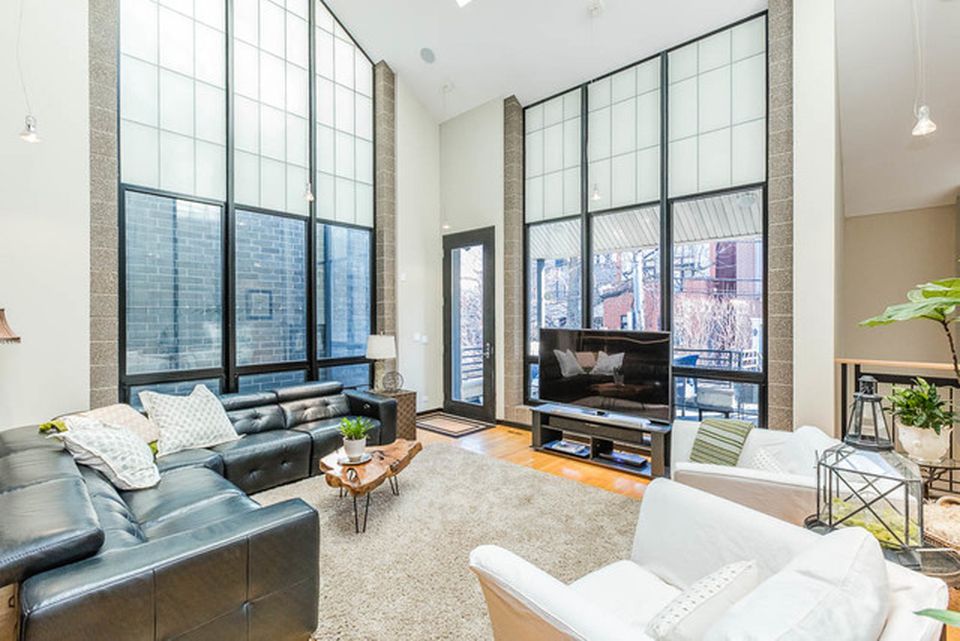
Photos courtesy of d’aprile properties.

Photo courtesy of Douglas Elliman Real Estate.
This five-bed, six-bath Los Angeles listing is also equipped with Control4 for both security and entertainment purposes — light, sound, locks and screens can be adjusted with a simple swipe.
While the average homeowner may not have a heated driveway or plant watering system that they control from their smartphone like Oprah Winfrey, the increasing accessibility of smart home technology makes the possibilities for a luxury home endless.

Freedom Learning Group's President
Stacey Ecelbarger
A collaboration between two organizations ensures that the scientific and technical expertise of military spouses is fully deployed.
In our appreciation for active military service personnel, the sacrifices made by their families — including military spouses with advanced degrees putting their own careers on hold — are sometimes overlooked. A partnership between Freedom Learning Group LLC (FLG) and the Society of Military Spouses in STEM (SMSS) aims to fully utilize the talents of these men and women in technical fields.
CEO Nathan Ecelbarger, a former police officer and U.S. Marine Corps reservist currently deployed to Stuttgart, Germany, co-founded FLG in 2016 with his wife, Stacey. She serves as president and has a keen appreciation for the challenges facing military families. “When we arrived overseas, I realized that highly qualified military spouses were getting jobs at the coffee shop on base just to fill a gap on their resume,” recounts Stacey. She remembers thinking, “This is not right. These underemployed attorneys, engineers and scientists should be able to utilize their expertise even while stationed overseas.”
As an adjunct professor in law enforcement, Nathan was introduced to the use of educational content experts by college textbook publishers like Pearson and McGraw-Hill. “Subject matter experts are a lifeline to publishers. Compared to full-time tenured professors (with many competing priorities), military spouses are more motivated, more committed to quality work and always meet deadlines,” reports Nathan, who says those nomadic specialists are not just looking for employment, but for continued professional credibility. “A Ph.D. in civil engineering doesn’t want to work as a barista, but as an engineer,” he says, yet notes the transient nature of military life and language barriers overseas make that challenging. “Through contract work with FLG they can use their training to develop the educational standards for their own industry,” explains Nathan.
“The need for reliable, qualified subject matter expertise is continuously increasing across the educational publishing industries,” says Stacey, adding, “Military spouses are extremely efficient, team-oriented and intrinsically do things right the first time.” Her husband, who explains that FLG trains content providers to write like educators, quips, “Having to navigate their way through the military bureaucracy as part of their lifestyle, military spouses are already, by definition, project managers and educators.”
“We’re thrilled to partner with SMSS, as our missions closely align and we share a common goal to empower and support military spouses,” explains Stacey, whose company also has affiliations with organizations representing specialties like law and healthcare. “By providing high-quality, affordable services to our clients, we look forward to employing more science, technology, engineering and mathematics (STEM) professionals, keeping them working in their chosen fields from any location on the globe,” she says.
Nonprofit SMSS was founded in 2016 by military spouses determined to maintain their careers despite the challenges presented by the military lifestyle. “We’re delighted to partner with a company that understands the needs for remote employment in STEM, and also has personal knowledge of what veterans and military spouses face,” says SMSS co-founder and Director of Outreach Michelle Aikman, who is herself a chemical engineer.
“We’ve been really fortunate to employ almost 100 military spouses,” says Stacey. She reports her company’s first military spouse hire, an unemployed engineer stationed in Germany, has since been promoted to FLG’s Senior Project Director developing educational content for the world’s biggest publishers while managing editorial teams of military spouses just like her.


Ekster, the world’s largest smart wallet brand, recently launched its third-generation product line with over $1 million gained from its crowd-funding campaign.
This time they have engineered both the slimmest and the first voice-activated smart wallet to date. With a collection of smart products designed for an efficient and secure everyday carry, Ekster’s products help to safeguard your daily accessories in the most stylish manner.
The first voice-activated smart wallet, Ekster’s products are compatible with Google Assistant and Amazon Alexa. This means you can now locate your wallet or phone using your smart speaker or even just use voice command on your phone using either of the two apps. “This is the first solar-charged smart wallet on the market, which means you won’t ever have to charge or replace your tracker batteries,” says Ekster co-founder Richard Canneman. This patented solar-charging solution does not require direct sunlight to charge and only requires three hours of charge time to last two months with full worldwide tracking functionality.
Partnering with Chipolo, a creator of the world’s slimmest and loudest tracking devices, owners can ring their wallet, find it on a map or make use of the widespread community to help locate their missing belongings. Each tracker has a unique QR code that links it to your smartphone like a fingerprint. If your wallet is lost and someone finds it, by scanning this QR code a message will be sent to you, immediately letting you know where the wallet is. Seamlessly designed with luxury in mind, these wallets are made with handcrafted premium leather available around the globe, sourced from LWG gold-rated tanneries who serve only top-of-the-line luxury leather brands.
Ekster was first brought to life in Rotterdam by Canneman and two other Dutch founders who shared a frustration with the everyday carry products offered in the market. Today, the company finds itself as the largest smart wallet brand worldwide, with products available in hundreds of stores ranging from Macy’s to Selfridges. Though their reach extends across the globe, no expense is spared on even the smallest detail. Every product that makes it through the company’s detail-oriented design process adheres to five criteria that distinguishes these products from the others on the market: efficiency, safeguarding, innovation, quality craftsmanship and style.
“We named our company Ekster after the Dutch word for ‘magpie,’ a bird who often hides its high intelligence, and has a taste for finding and protecting shiny objects,” says the brand. “Just like this bird, we wanted to create classically attractive leather products jam-packed with hidden technology to easily access and protect important everyday valuables.”


Photos courtesy Ekster.
Interest and research in driverless and self-parking cars is rapidly growing, as are ideas for how this technology may impact housing development.
By Camilla McLaughlin
The race is on among car manufacturers, tech companies and cities to develop reliable self-driving vehicles and required innovative infrastructure in what is being characterized as the third transportation revolution, one that possibly could have as dramatic of an impact as the automobile. Personal vehicles are only one facet of this future vision. Ride hailing services, shared ownership of cars, autonomous shuttles and buses, and self-driving trucks are all part of the scenario, along with Wi-Fi-enabled infrastructure and roadways that could charge cars.
To illustrate how dramatic the transformation might be, futurist Jack Uldrich uses two photos of Fifth Avenue in Manhattan. In a shot from 1900, horse-drawn vehicles fill the roadway. Thirteen years later, only one horse-drawn vehicle is in evidence, and cars and trucks take up the entire street.
“The transportation revolution will be a game changer for most real estate sectors” is the prediction of Green Street Advisors in a report, The Transportation Revolution: The impact of ride-hailing and driverless vehicles on real estate, prepared for the Urban Land Institute’s fall 2017 meeting.
“Most experts agree that the automobile as we know it will be largely obsolete by 2030. In its place will be fleets of driverless cars that shuttle people safely and efficiently through our city streets. But it’s the broader impacts of this technology that are a game-changer for the future of our cities and the human experience. The opportunity is not only to create new places that accommodate driverless cars, but to reshape our existing cities and towns into the kind of amenity-rich, vibrant places that we all enjoy,” observed architect Andy Cohen, co-CEO of Gensler.
Although a vast array of regulatory and legal challenges need to be addressed, consumer acceptance is considered most pivotal to the broader adaption of autonomous vehicles (AVs). Right now, few consumers have tried self-driving cars. Experts agree acceptance will only come with knowledge and experience.
One analogy often used to illustrate current apprehensions about new technology is the elevator, which initially was considered an incredibly risky innovation. “People didn’t want to get into it. Today, you and I don’t give a second thought to jumping on an elevator, and it whisks us up a hundred stories of a skyscraper. I think that same thing is going to happen with autonomous vehicles. We’re just soon going to get in a car, press a button and it’ll take us to our destinations without our thinking of it,” says Uldrich, who says the impact of the elevator also gives insight into the effect of technology on luxury real estate. “Before the elevator, wealthy people lived on the ground floor, and they made the servants walk up the stairs. But with the invention of the elevator, the penthouse then become the most desirable space. And so, technology sort of changed behavior in a curious way.”
“For consumers, the tipping point for large-scale adoption will come when not owning a car makes more financial and logistical sense than traditional ownership. Car enthusiasts, the affluent, and rural households will continue to own cars as AVs evolve,” explains Rich Palacios Jr., head of research for John Burns Consulting. Still, real estate agents in cities with high levels of congestion such as Boston or San Francisco are beginning to hear comments from high-end clients that they are planning to reduce the number of vehicles they own.

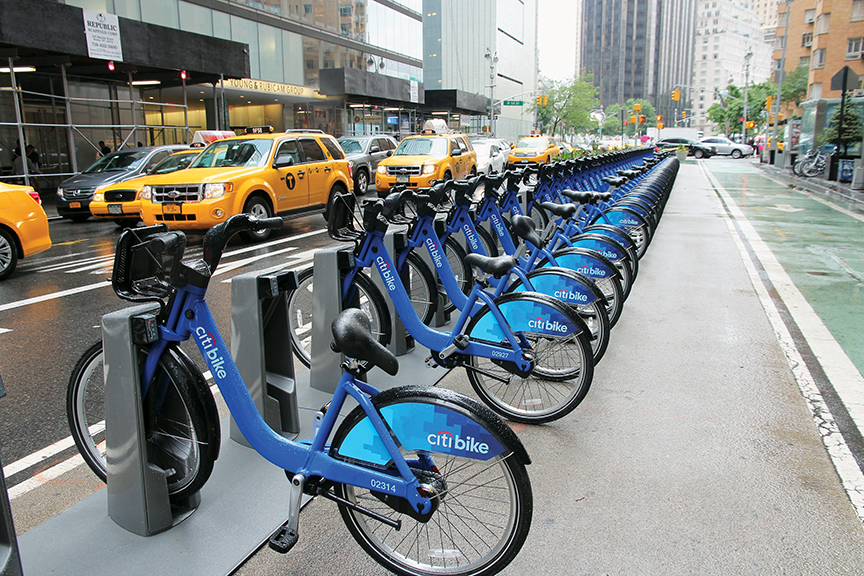
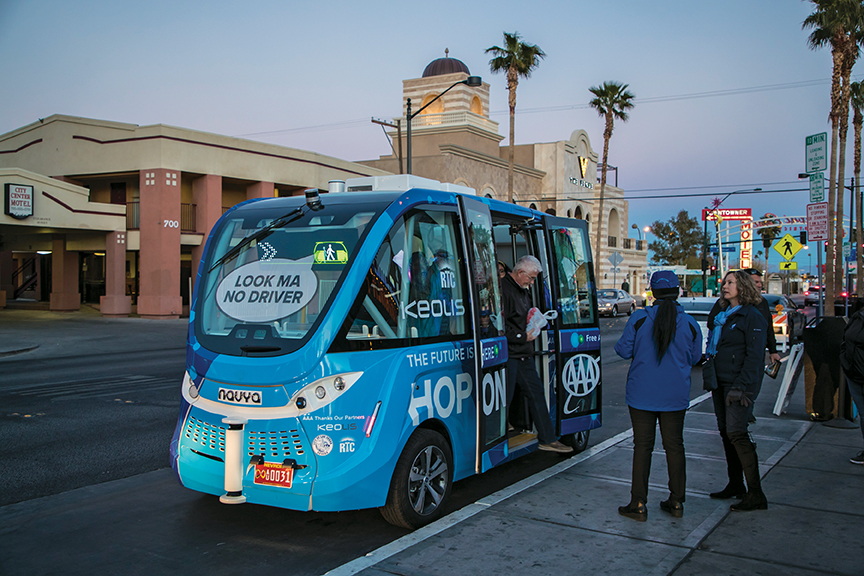
Even though many well-informed experts weigh in with varied opinions on potential transformations for real estate and housing, the only certainty is the change will be incremental, disruptive and far-reaching. “So, what impact will AVs and ride-sharing have on the housing market? We think a big one,” says Palacios. “A portion of the money once allotted to owning/renting a car should also free up for owning or renting a home.” As cars become more of a commodity, rather than a possession, costs such as fuel, maintenance and insurance will disappear along with loan/lease payments. “The boost to disposable income will be significant, once scaled,” says Palacios. Increases in productivity for individuals as well as industry are another expected result that will drive economic growth.
When the price of a parking space can exceed $300,000 or $400,000, even high-end consumers begin to examine the value of owning multiple vehicles. Conservative estimates suggest demand for parking could decline by 50 percent or more, freeing up extensive prime acreage. Already, in cities such as Chicago and Philadelphia, some former surface parking lots are being repurposed as mixed use or residential towers. Not only will the need for parking near prime buildings be eliminated, but overall, individual parking spaces will be smaller because autonomous vehicles do not require space to open and close doors when parked.
Some parking garages today are being designed with future adaptation to office or residential purposes in mind. Speaking at Trends 2018 sponsored by ULI Arizona, Veronica Siranosian, senior project manager with the global architecture and engineering planning firm AECOM Ventures, said they are recommending building new parking garages with flat floors and higher ceilings with the potential for HVAC and electrical.
Other changes she anticipates include mobility hubs that would incorporate bike share, drop off and pick up, automated shuttles and perhaps access to transit in one location. Additionally, building and street design will also have to consider added spaces for pick up and drop off.
Since most autonomous vehicles will be electric, the number of gas stations will also decline, further unlocking acres of what Palacios calls “prime real estate.” This reclaimed acreage will also improve the supply of homes in locations where inventories have historically been constrained, possibly dampening appreciation and enhancing affordability.
For a while, new construction in cities or close-in locations might impact interest in real estate in outlying suburbs, but in the long run demand for distant suburbs will reemerge as consumers realize they can use the time involved with longer commutes productively.
Overall, most expect to see a continued revival of cities. “What I am most excited about related to self-driving vehicles is society’s ability to envision better uses of the all-public space that is currently devoted to automobiles. In the future, I believe cities will have more green spaces, public parks, wider boulevards, and, perhaps, more affordable housing because we will be able to convert our garages and parking garages into fully functional living spaces,” says Uldrich.
“Get ready for more homes per acre, with the days of wide streets, massive driveways, and two-/three-car garages a thing of the past,” predicts Palacios. Higher density might be one potential outcome for residential real estate, but for consumers the result will be more livable square footage.


While fully autonomous driving seems many years away, planners and developers are already rethinking how new development needs to be planned. “We’re already seeing apartment developers shifting to zero parking. Innovative master-planned communities such as Florida’s new Babcock Ranch (eventually home to 50,000 residents) are already utilizing AV community shuttles, with the goal of having on-demand AVs that individual residents can use via smart-phone apps,” says Palacios.
For current homeowners, unused garage space will offer a range of opportunities to add amenities or create new uses from live/work options to multigenerational spaces.
For an aging population, new transportation options will be a game changer with the potential to alter where and how they live. Most projections envision a growing number staying in their existing homes rather than moving to assisted living.
The transportation revolution also makes a bullish case for the repair and remodel industry, and adaptation of homes for aging in place is only part of the push for renovations. The conversion of garages will also boost this real estate sector.
Two years ago, the idea of self-driving cars seemed more like science fiction than a near-term possibility. Today, despite the first traffic fatality from an AV, the push to develop this technology remains strong. Major automakers including General Motors and Ford as well as Waymo (a unit of Google’s Alphabet), Lyft and others continue to actively pursue the technology for both cars and trucks. A majority of automakers are moving toward semi-autonomous vehicles. GM, for example, has added hands-free cruise control to their Cadillac line along with vehicle-to-vehicle (V2V) communication with similarly equipped vehicles that alerts drivers to disabled vehicles, sudden stops or a crash ahead. It’s also a good example of how autonomous vehicles will eventually communicate with one another as well as with infrastructure. GM recently petitioned the federal government to begin testing cars without steering wheels and pedals.
The National Transportation Safety Board defines five levels of vehicle autonomy. Current vehicles fall into levels 2AV and 3AV. One anticipated transition to fully autonomous vehicles at Level 5 is dedicated travel lanes enabling them to trail closer together and communicate with each other and infrastructure. Hypothetically, this scenario would facilitate the movement of traffic, but some experts hazard that AVs will only increase congestion.
California and Arizona are on the forefront of the transportation revolution, incubating new technologies including potential use without a driver in the car. In late January, Waymo got a permit to operate as a Transportation Network Company in Arizona, which allows Waymo’s fleet of driverless minivans to pick up and drop off paying riders through a smartphone app or website. Other states including Texas, Ohio and Michigan are also proactively working on AVs.
Any look ahead also requires a look back at predictions that went wrong, including one notable projection, pegging the number of cellular phones at the end of the 20th century at just under a million. For driverless vehicles, estimates of the time frame for adoption might not hit the mark, but few would deny that transportation’s future will not involve steering wheels and brake pedals.
Appearing in UH Summer 2018, “Ten Years Later: Our year-long look at what’s changed in U.S. luxury real estate since the 2008 recession.”
Consumer sentiments toward owning and buying real estate continue to evolve, along with the definition of luxury.
By Camilla McLaughlin
Ten years ago, there were few signposts for the journey out of the recession. Real estate’s perfect storm got a lot worse in the summer and fall of 2008 as a combination of job losses, high energy costs, an ongoing tide of foreclosures, a pending presidential election and the near collapse of the credit markets rocked the economy. Many, but not all, upscale consumers put real estate plans on hold and shifted into a watch-and-wait mode. “Consumers’ confidence gets shaken, and the rich are not immune,” observes John Brian Losh, publisher of Luxuryrealestate.com and owner of Seattle brokerage Ewing & Clark.
Following that low point, luxury real estate embarked on a remarkable journey of recovery with luxury properties selling and prices escalating in many locations, boosted in part by the exponential growth of wealth worldwide. Just in the last year, the combined net worth of the world’s billionaires increased by 18 percent. Residential real estate remains a favored investment with prime property sales worldwide up by 11 percent in 2017.
Attitudes toward buying, selling and luxury overall have followed an equally transformative path. “The lesson from the recession is to buy smart. Impulse buying, overextending to get the home of your dreams, and buying without doing your homework have all gone the way of the fax machine,” says Jason Haber, a broker at Warburg Realty in Manhattan.
Value is most important. Greenwich saw two record sales in 2017, but only after list prices were reduced. In their luxury white paper, Christie’s International Real Estate reported strong sales “where buyers and sellers showed a willingness to adjust pricing expectation to new market realities.”
“Price was the name of the game,” said Michael Saunders of Michael Saunders & Company, noting that luxury homes in Sarasota sold in record numbers after homeowners adjusted prices.
Affluent individuals also have a new perspective on the investment potential of properties, locations for both primary and second homes, expectations regarding the agent’s role in the transaction and what constitutes luxury.
What Is Luxury?
Few other terms have been hyped more than the word “luxury” in recent years. Most industry experts would agree with Mike Leipart, managing partner of The Agency Development Group in Beverly Hills, who says, “It’s used so often that it’s become virtually meaningless.”
Even wealthy consumers struggle to find a suitable alternative phrase, yet they have a clear understanding of what luxury means today. “I think people can’t describe it, but when you walk into it, when you are standing in it, you respond to it,” says Craig Hogan, vice president of luxury, Coldwell Banker Real Estate. “People can tell quality; they can tell beautiful design. Service is critical.”
“Ten years ago, the luxury industry was able to dictate to consumers what luxury was and almost define it for them. We are not able to do that today,” explains Kevin Thompson, CMO of Sotheby’s International Realty Affiliates LLC. “Luxury is being viewed from an experiential perspective. People are choosing to live different ways and somehow have what they value. It is a very individual approach.”
“The meaning of luxury has changed a lot. I think luxury has become personal. It’s become a feeling. It’s become an emotional part of a real estate experience,” says Christina Huffstickler, owner of Engel & Völkers in Atlanta.
“You can’t pin it to price level or finish levels. It’s very complex. It’s very much what people are willing to pay extra for,” says Leipart using the example of how a desirable view — prized by today’s buyers — amps up a per square foot price. “I think the basic thing of luxury is that it is everything that has not been commodity priced,” he explains.
Value & Inventories
“By and large, people value home ownership,” shares Hogan. “I just keep watching this trend toward smaller and more wonderful. Just beautiful in every way. Great finishes, smart home technology, all the things you’d expect except beyond those expectations.”
“I think that people, wealthy people, have always found real estate to be an attractive investment. It’s an asset that usually appreciates that they can enjoy,” says Losh.
Coming out of recession, the Bay Area led the recovery, and the region continues to rack up amazing stats with May’s median sold price exceeding $3 million in both San Francisco and Silicon Valley, according to The Institute for Luxury Home Marketing. Inventories remain barebones with homes selling in weeks. In fact, the median time it takes for both attached and single-family homes to sell in Silicon Valley is about nine days. Here, as in many other upscale locations, the biggest issue is too few listings to satisfy demand.
“Even with interest rates rising because of the moves the Feds have been making the last 18 months, there is no slowdown in the appetite for wealthy consumers purchasing homes,” says Jim Walberg with Pacific Union, noting, he has never seen more all cash purchases in 35 years. “Buyers and sellers still view Bay Area real estate as a great place to put their resources. And, remember, these are wealthy people, so it’s not as if they are not diversified in many other investment categories.“ Many of these purchasers are looking at long-term ownership. The homes have a dual purpose: a fun community and place to raise their kids, and a home they plan to live in after their children are grown.
“The primary residence purchase remains largely emotionally driven based on finding the right property to suit the purchaser’s desire for location, space, finishes, et cetera,” rather than a cold calculation of investment dollars,” says Leslie Hirsch, an advisor with Engel & Völkers in New York City.
Second Homes & Investments
Second homes and resort properties are in demand. More than half of the world’s high- and ultra-high-net-worth individuals own two or more residences, and many sought out at least one luxury property acquisition in 2017 and 2018, say experts at Christie’s International Real Estate in their annual industry report.
Among the U.S. population with a net worth of $500 million and up, 2,700 own on average 10 or more homes each, shares Hogan.
“An interesting trend we have noticed is that more wealthy clientele are electing to purchase properties as investment pieces instead of purchasing a third or fourth home to use as a personal residence. Or in some cases they are using a single property as both a vacation home and income property,” shares Anthony Hitt, CEO of Engel & Völkers Americas.
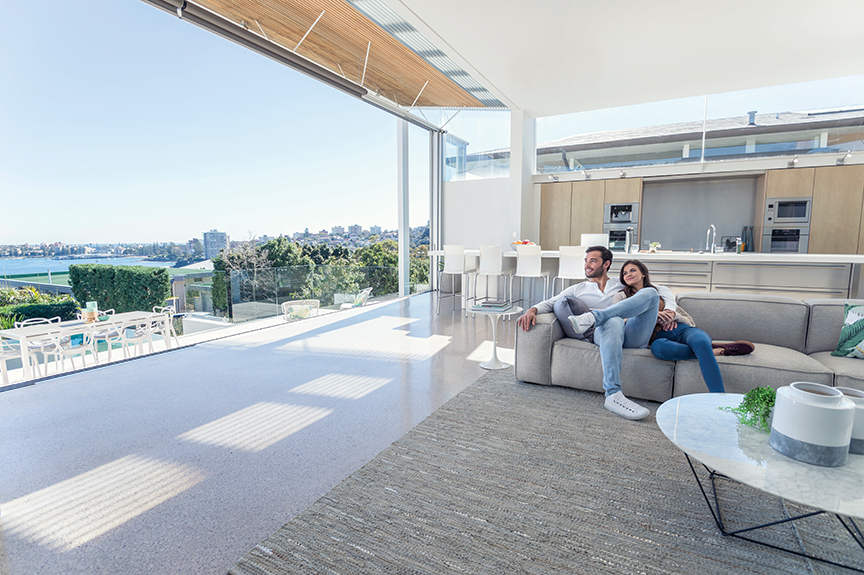
“Second, third and fourth homes are now being scrutinized more carefully to make sure there is an upside in the investment should the purchase decide to sell in the future,” says Hirsch. Investors are diversifying portfolios, she says, “choosing to buy property in several countries as a hedge against a drastic change in one country’s economy.”
Affluent consumers continue to be bullish on real estate, an attitude enhanced by recent volatility in equity markets. Losh believes security and safety are more important to consumers. “People are also looking for a safe harbor. They want to feel safe, and they want their investment to be secure,” he says.
What Buyers Want
Ten years ago, the luxury echeleon was defined as homes priced in the top 10 percent of any market, and that benchmark still stands. But for consumers, dollar signs do not necessarily determine luxury. “Money sometimes doesn’t even become part of the search parameters. They just want to find the right property,” and these buyers today are willing to take their time, says Katie Hauser, a broker associate with Baird & Warner in Winnetka, Illinois.
Like many agents today, Hauser sees several different buyer profiles in the market. Some, particularly empty nesters, “want to ditch their suburban house for something unique. They want value, but they want to find the right place,” she says.
“There is a search for the unique. The emerging luxury consumer isn’t interested in cookie-cutter anything. They want personal and outside the norm and are willing to pay more for that,” adds Thompson.
On the other hand, other upscale buyers want a platinum location and are extremely discerning regarding every facet of the property.
“Luxury buyers in Omaha want what they want, and if they cannot find it they build,” says Judy Smith with RE/MAX Real Estate Group in Omaha. High on wish lists are rooms large enough for grand pianos, buffets and sideboards. “They still love walk-out basements for entertaining and as a separate living area for family members extended visits. The view from the deck is always important.”
Millennials
Millennials are beginning to make their play in real estate. Because they delayed buying a home, many of their first purchases fall into the luxury niche, giving new meaning to “starter home.”
According to research from Luxury Portfolio International, most buyers seeking $1 million-plus homes are 25 to 49 years old and have inherited or plan to inherit significant wealth. This consumer has begun powering the $1 million-plus real estate market, more so than their older counterparts.
Millennials overall, says Lindsay Bacigalupo, an Engel & Völkers licensed partner in Minneapolis, “waited to buy and are now in their late 20s and early 30s. They are buying starter homes that are $400,000 to $1 million.
Millennials expected to be as transformative for real estate as the baby boomer cohort was. “Millennials are the next generation who are redefining luxury. Their attitudes toward homes are shaping what is publically seen as ‘good real estate,’ influencing what others look for in a home,” says John Dean, license partner with Engel & Völkers Vancouver. “Millennials are rejigging real estate wish lists, which differ from past generations. They place a big focus on the shared economies. They prioritize modern design. They see real estate differently than predecessors as big traditional homes are too expensive for them to afford, at least right now.”
“Bigger is a little yesterday,” says Hogan, who characterizes current preferences among all consumers as “smaller and finer.”
The drive for a safe harbor along with quality of life, changing demographics, government tax policies and technology are all reshaping the geography of luxury. Denver, Nashville and Atlanta are new luxury players. Victoria, British Columbia topped Christie’s annual report as the primary luxury market. Santa Fe was the hottest second home market; Sun Valley and the Bahamas were in the top five.
More consumers are also opting to make places such as Charleston, South Carolina; Austin or Orlando home. A number are also trading their primary home for a resort home in locations such as Jackson Hole or Bluffton, South Carolina, and many are doing so with kids in tow.
“The definition of luxury means something different to millennials than previous generations. As we know, they value the experience of material wealth. They may choose to settle in traditionally second-home markets to be close to the beach or mountains. They are not as tied to a specific geographic area as many have the option to work remotely,” explains Hitt.

Technology & the Agent’s Role
Probably nothing has changed more, as well as stayed the same, as the way homes are sold and how real estate agents work with buyers and sellers. “Technology has played a huge role in changing everything we do now as agents,” says Dean.
Buyers are more knowledgable; the mechanics of the transaction are more streamlined. Artificial intelligence and virtual reality are starting to kick off the next tech evolution.
The agent’s role continues to shift from provider of information to trusted advisor. “Today’s buyer comes armed with data, comps, neighborhood analysis, and newspaper articles. In some cases they know more about pricing than the listing agent,” says Haber.
What agents need to understand, Leipart says, is, “you don’t sell anything” to the wealthy. “If your approach is to get them to buy, you are going to strike out every time. The best you can hope for is to be a trusted advisor, and you can’t have that role if you are trying to sell.”


